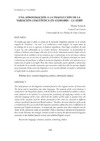Please use this identifier to cite or link to this item:
https://accedacris.ulpgc.es/jspui/handle/10553/135952
| Title: | Una aproximación a la traducción de la variación lingüística en Gomorra – la serie | Authors: | Vedaschi Ozzola, Matias Cruz García, Laura |
UNESCO Clasification: | 57 Lingüística | Keywords: | Variación lingüística Análisis |
Issue Date: | 2019 | Journal: | E-Aesla | Conference: | XXXVII Congreso Internacional de la Asociación Española de Lingüística Aplicada (AESLA 2019) | Abstract: | El estudio que aquí se ofrece se centra en la variación lingüística presente en la versión
original de “Gomorra – La serie” y su traducción a otras lenguas. La mayor parte de
los diálogos de la serie se expresan en dialecto napolitano. Para llegar al público de todo
el país, ha sido subtitulada en su versión italiana. Precisamente, la peculiaridad de
utilizar el dialecto como lengua vehicular de la serie ha despertado nuestras dudas sobre la
transmisión de la realidad y de las temáticas que se representan en la serie hacia culturas
diferentes, que son, en este caso, la española y la británica. El objetivo principal, por tanto,
es determinar de qué forma se refleja la variación lingüística de dicha serie televisiva en su
traducción al español y al inglés. Para ello, hemos analizado cuatro capítulos y ofreceremos
los resultados de un estudio contrastivo, que mostrarán cuáles han sido las opciones elegidas
para transmitir dicha variación lingüística en su versión doblada al español y subtitulada
al inglés desde un enfoque teórico-práctico. This study focuses on the linguistic variation found in the original version of Gomorrah: The Series and its translation into other languages. The majority of the series’ dialogue is conducted in the Neapolitan dialect, with the Italian version subtitled to enable a countrywide audience to be reached. It is precisely this peculiarity, of employing a dialect as the vehicular language of the series, which led the authors of this study to question how the reality of the situation and the themes portrayed in the series are conveyed to different cultures, specifically Spanish and British cultures. Therefore, the main objective of this study is to determine the way in which the linguistic variation within this series is reflected in its Spanish and English translations. Consequently, four episodes have been analysed and the results of the contrastive study are presented. From a theoretical and practical perspective, these results illustrate the strategies selected in order to convey the aforementioned linguistic variation in the dubbed Spanish version and subtitled English version. |
URI: | https://accedacris.ulpgc.es/handle/10553/135952 | ISSN: | 2444-197X | Source: | E-Aesla [ISSN-e 2444-197X], n. 6, p. 290-303 (2020) | URL: | https://cvc.cervantes.es/lengua/eaesla/eaesla_06.htm |
| Appears in Collections: | Actas de congresos |
Items in accedaCRIS are protected by copyright, with all rights reserved, unless otherwise indicated.
